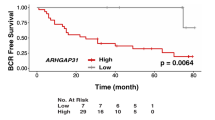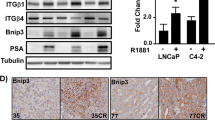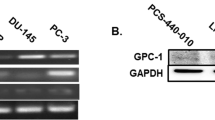Abstract
Background:
The influence of the bisphosphonate zoledronic acid (ZA) on prostate cancer (PC) growth, adhesion and invasive behavior was investigated.
Methods:
PC-3, DU-145 and LNCaP cells were treated with ZA, and tumor-cell growth was then investigated by the 3-(4,5-dimethylthiazol-2-yl)-2,5-diphenyltetrazolium bromide assay. Furthermore, tumor-cell adhesion to vascular endothelium or to immobilized extracellular matrix proteins, as well as migratory properties of the cells, was evaluated. Integrin β subtypes, integrin-dependent signaling, as well as cell-cycle regulating proteins, were analyzed by western blots.
Results:
ZA dose-dependently reduced tumor-cell growth but did not impair tumor–endothelium and tumor–matrix interaction. However, ZA significantly inhibited tumor migration and invasive activity. Cyclin E was reduced by ZA in LNCaP and DU-145, and p21 was elevated in LNCaP cells. p27 was upregulated in all tumor cell lines, compared with the controls. ZA elevated β1-integrin in PC-3 and diminished β4-integrin in PC-3 and DU-145 cells.
Conclusions:
ZA inhibits PC growth and motility but does not influence the mechanical contact between tumor cells and the vascular wall.
This is a preview of subscription content, access via your institution
Access options
Subscribe to this journal
Receive 4 print issues and online access
$259.00 per year
only $64.75 per issue
Buy this article
- Purchase on Springer Link
- Instant access to full article PDF
Prices may be subject to local taxes which are calculated during checkout





Similar content being viewed by others
References
Bubendorf L, Schöpfer A, Wagner U, Sauter G, Moch H, Willi N et al. Metastatic patterns of prostate cancer: an autopsy study of 1589 patients. Hum Pathol 2000; 31: 578–583.
Ho JW . Bisphosphonate stimulation of osteoblasts and osteoblastic metastasis as a mechanism of hypocalcaemia. Med Hypotheses 2012; 78: 377–379.
Saad F, Gleason DM, Murray R, Tchekmedyian S, Venner P, Lacombe L et al. A randomized, placebo-controlled trial of zoledronic acid in patients with hormone-refractory metastatic prostate carcinoma. J Natl Cancer Inst 2002; 94: 1458–1468.
Luckman SP, Hughes DE, Coxon FP, Graham R, Russell G, Rogers MJ . Nitrogen-containing bisphosphonates inhibit the mevalonate pathway and prevent post-translational prenylation of GTP-binding proteins, including Ras. J Bone Miner Res 1998; 13: 581–589.
Saad F, Gleason DM, Murray R, Tchekmedyian S, Venner P, Lacombe L et al. Long-term efficacy of zoledronic acid for the prevention of skeletal complications in patients with metastatic hormone-refractory prostate cancer. J Natl Cancer Inst 2004; 96: 879–882.
Hung TT, Chan J, Russell PJ, Power CA . Zoledronic acid preserves bone structure and increases survival but does not limit tumour incidence in a prostate cancer bone metastasis model. PLoS One 2011; 6: e19389.
Di Salvatore M, Orlandi A, Bagalà C, Quirino M, Cassano A, Astone A et al. Anti-tumour and anti-angiogenetic effects of zoledronic acid on human non-small-cell lung cancer cell line. Cell Prolif 2011; 44: 139–146.
Koto K, Murata H, Kimura S, Horie N, Matsui T, Nishigaki Y et al. Zoledronic acid inhibits proliferation of human fibrosarcoma cells with induction of apoptosis, and shows combined effects with other anticancer agents. Oncol Rep 2010; 24: 233–239.
Sewing L, Steinberg F, Schmidt H, Göke R . The bisphosphonate zoledronic acid inhibits the growth of HCT-116 colon carcinoma cells and induces tumor cell apoptosis. Apoptosis 2008; 13: 782–789.
Li YY, Chang JW, Chou WC, Liaw CC, Wang HM, Huang JS et al. Zoledronic acid is unable to induce apoptosis, but slows tumor growth and prolongs survival for non-small-cell lung cancers. Lung Cancer 2008; 59: 180–191.
Lee MV, Fong EM, Singer FR, Guenette RS . Bisphosphonate treatment inhibits the growth of prostate cancer cells. Cancer Res 2001; 61: 2602–2608.
Oades GM, Senaratne SG, Clarke IA, Kirby RS, Colston KW . Nitrogen containing bisphosphonates induce apoptosis and inhibit the mevalonate pathway, impairing Ras membrane localization in prostate cancer cells. J Urol 2003; 170: 246–252.
Dumon JC, Journé F, Kheddoumi N, Lagneaux L, Body JJ . Cytostatic and apoptotic effects of bisphosphonates on prostate cancer cells. Eur Urol 2004; 45: 521–528.
Clyburn RD, Reid P, Evans CA, Lefley DV, Holen I . Increased anti-tumour effects of doxorubicin and ZA in prostate cancer cells in vitro: supporting the benefits of combination therapy. Cancer Chemother Pharmacol 2010; 65: 969–978.
Almubarak H, Jones A, Chaisuparat R, Zhang M, Meiller TF, Scheper MA . ZA directly suppresses cell proliferation and induces apoptosis in highly tumorigenic prostate and breast cancers. J Carcinog 2011; 10: 2.
Karabulut B, Karaca B, Atmaca H, Kisim A, Uzunoglu S, Sezgin C et al. Regulation of apoptosis-related molecules by synergistic combination of all-trans retinoic acid and ZA in hormone-refractory prostate cancer cell lines. Mol Biol Rep 2011; 38: 249–259.
Sonnemann J, Bumbul B, Beck JF . Synergistic activity of the histone deacetylase inhibitor suberoylanilide hydroxamic acid and the bisphosphonate ZA against prostate cancer cells in vitro. Mol Cancer Ther 2007; 6: 2976–2984.
Lin P, Sun X, Feng T, Zou H, Jiang Y, Liu Z et al. ADAM17 regulates prostate cancer cell proliferation through mediating cell cycle progression by EGFR/PI3K/AKT pathway. Mol Cell Biochem 2012; 359: 235–243.
Kannaiyan R, Manu KA, Chen L, Li F, Rajendran P, Subramaniam A et al. Celastrol inhibits tumor cell proliferation and promotes apoptosis through the activation of c-Jun N-terminal kinase and suppression of PI3K/Akt signaling pathways. Apoptosis 2011; 16: 1028–1041.
Marra M, Santini D, Meo G, Vincenzi B, Zappavigna S, Baldi A et al. Cyr61 downmodulation potentiates the anticancer effects of zoledronic acid in androgen-independent prostate cancer cells. Int J Cancer 2009; 125: 2004–2013.
Pandhare-Dash J, Mantri CK, Gong Y, Chen Z, Dash C . XMRV accelerates cellular proliferation, transformational activity, and invasiveness of prostate cancer cells by downregulating p27(Kip1). Prostate 2011; e-pub ahead of print 19 September 2011; doi: 10.1002/pros.21491.
Roy S, Singh RP, Agarwal C, Siriwardana S, Sclafani R, Agarwal R . Downregulation of both p21/Cip1 and p27/Kip1 produces a more aggressive prostate cancer phenotype. Cell Cycle 2008; 7: 1828–1835.
Ananthanarayanan V, Deaton RJ, Amatya A, Macias V, Luther E, Kajdacsy-Balla A et al. Subcellular localization of p27 and prostate cancer recurrence: automated digital microscopy analysis of tissue microarrays. Hum Pathol 2011; 42: 873–881.
Romics I, Bánfi G, Székely E, Krenács T, Szende B . Expression of p21(waf1/cip1), p27 (kip1), p63 and androgen receptor in low and high Gleason score prostate cancer. Pathol Oncol Res 2008; 14: 307–311.
Fang Z, Zhang T, Dizeyi N, Chen S, Wang H, Swanson KD et al. Androgen receptor enhances p27 degradation in prostate cancer cells through rapid and Selective TORC2 activation. J Biol Chem 2012; 287: 2090–2098.
Moriceau G, Ory B, Mitrofan L, Riganti C, Blanchard F, Brion R et al. Zoledronic acid potentiates mTOR inhibition and abolishes the resistance of osteosarcoma cells to RAD001 (Everolimus): pivotal role of the prenylation process. Cancer Res 2010; 70: 10329–10339.
Morgan TM, Pitts TE, Gross TS, Poliachik SL, Vessella RL, Corey E . RAD001 (Everolimus) inhibits growth of prostate cancer in the bone and the inhibitory effects are increased by combination with docetaxel and zoledronic acid. Prostate 2008; 68: 861–871.
Zaman MH, Trapani LM, Sieminski AL, Mackellar D, Gong H, Kamm RD et al. Migration of tumor cells in 3D matrices is governed by matrix stiffness along with cell-matrix adhesion and proteolysis. Proc Natl Acad Sci USA 2006; 103: 10889–10894.
Boissier S, Ferreras M, Peyruchaud O, Magnetto S, Ebetino FH, Colombel M et al. Bisphosphonates inhibit breast and prostate carcinoma cell invasion, an early event in the formation of bone metastases. Cancer Res 2000; 60: 2949–2954.
Montague R, Hart CA, George NJ, Ramani VA, Brown MD, Clarke NW . Differential inhibition of invasion and proliferation by bisphosphonates: anti-metastatic potential of Zoledronic acid in prostate cancer. Eur Urol 2004; 46: 389–401.
Goel HL, Moro L, King M, Teider N, Centrella M, McCarthy TL et al. Beta1 integrins modulate cell adhesion by regulating insulin-like growth factor-II levels in the microenvironment. Cancer Res 2006; 66: 331–342.
Ramirez NE, Zhang Z, Madamanchi A, Boyd KL, O’Rear LD, Nashabi A et al. The α2β1 integrin is a metastasis suppressor in mouse models and human cancer. J Clin Invest 2011; 121: 226–237.
Bonaccorsi L, Carloni V, Muratori M, Salvadori A, Giannini A, Carini M et al. Androgen receptor expression in prostate carcinoma cells suppresses alpha6beta4 integrin-mediated invasive phenotype. Endocrinology 2000; 141: 3172–3182.
Drake JM, Barnes JM, Madsen JM, Domann FE, Stipp CS, Henry MD . ZEB1 coordinately regulates laminin-332 and {beta}4 integrin expression altering the invasive phenotype of prostate. J Biol Chem 2010; 285: 33940–33948.
Kovacevic Z, Sivagurunathan S, Mangs H, Chikhani S, Zhang D, Richardson DR . The metastasis suppressor, N-myc downstream regulated gene 1 (NDRG1), upregulates p21 via p53-independent mechanisms. Carcinogenesis 2011; 32: 732–740.
Acknowledgements
The authors thank Karen Nelson for critically reading the manuscript.
Author information
Authors and Affiliations
Corresponding author
Ethics declarations
Competing interests
The authors declare no conflict of interest.
Rights and permissions
About this article
Cite this article
Mani, J., Vallo, S., Barth, K. et al. Zoledronic acid influences growth, migration and invasive activity of prostate cancer cells in vitro. Prostate Cancer Prostatic Dis 15, 250–255 (2012). https://doi.org/10.1038/pcan.2012.9
Received:
Revised:
Accepted:
Published:
Issue Date:
DOI: https://doi.org/10.1038/pcan.2012.9
Keywords
This article is cited by
-
Effects of zoledronic acid on osteosarcoma progression and metastasis: systematic review and meta‐analysis
Clinical and Experimental Medicine (2022)
-
Cytotoxic and anti-angiogenic effects of zoledronic acid in DU-145 and PC-3 prostate cancer cell lines
Molecular Biology Reports (2020)
-
The Dentin Sialoprotein (DSP) Domain Regulates Dental Mesenchymal Cell Differentiation through a Novel Surface Receptor
Scientific Reports (2016)
-
Zoledronic acid induces apoptosis via stimulating the expressions of ERN1, TLR2, and IRF5 genes in glioma cells
Tumor Biology (2016)
-
New light shed on the anticancer effects of zoledronic acid
Nature Reviews Urology (2012)



